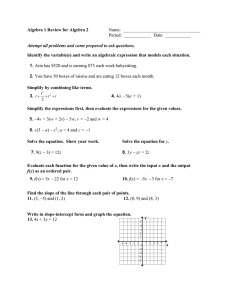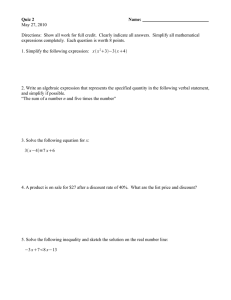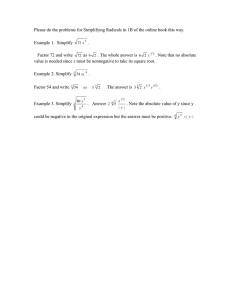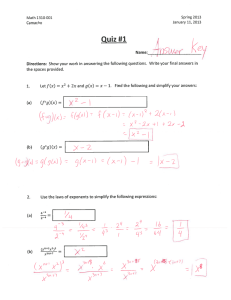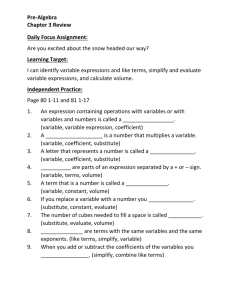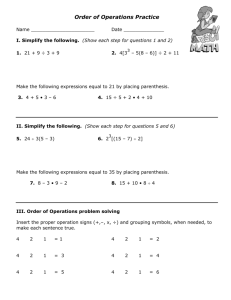INTRODUCTION TO ALGEBRA
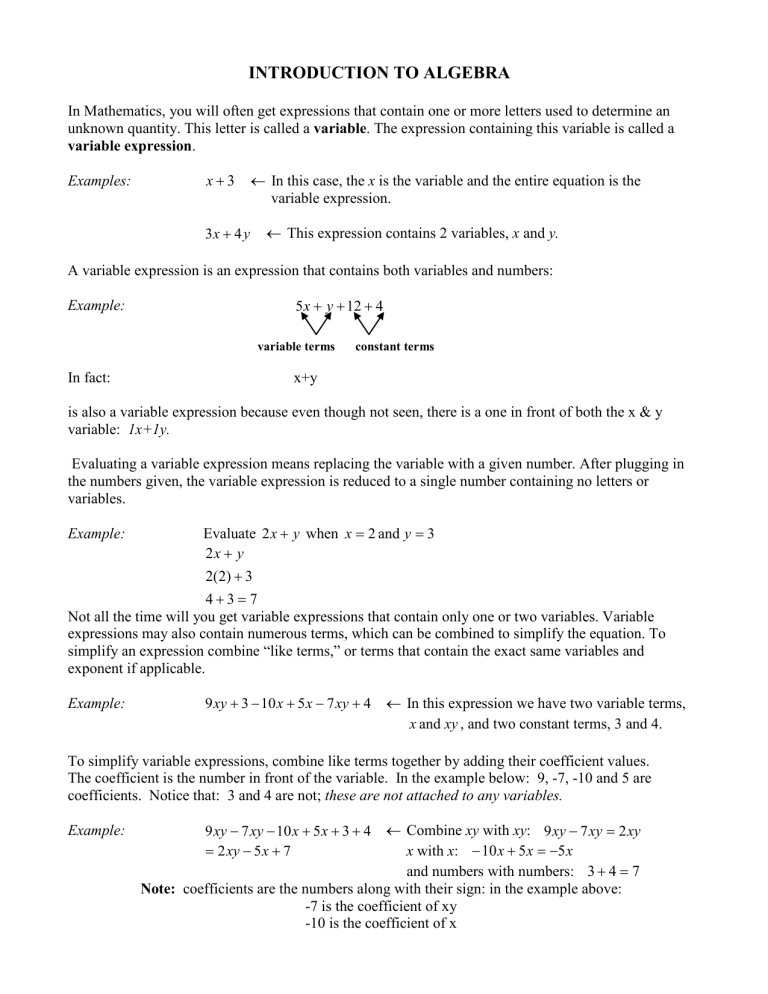
INTRODUCTION TO ALGEBRA
In Mathematics, you will often get expressions that contain one or more letters used to determine an unknown quantity. This letter is called a variable . The expression containing this variable is called a variable expression .
Examples: x
+
3
←
In this case, the x is the variable and the entire equation is the
variable expression. x 4 y 3
+ ←
This expression contains 2 variables, x and y.
A variable expression is an expression that contains both variables and numbers:
Example: 5 x
+ y
+
12
+
4
In fact: variable terms constant terms x+y is also a variable expression because even though not seen, there is a one in front of both the x & y variable: 1x+1y.
Evaluating a variable expression means replacing the variable with a given number. After plugging in the numbers given, the variable expression is reduced to a single number containing no letters or variables.
Example: Evaluate
2 x
+ y
2 x
+
2 ( 2 )
+
3 y when x
=
2 and y
=
3
4
+
3
=
7
Not all the time will you get variable expressions that contain only one or two variables. Variable expressions may also contain numerous terms, which can be combined to simplify the equation. To simplify an expression combine “like terms,” or terms that contain the exact same variables and exponent if applicable.
Example: 9 xy
+
3
−
10 x
+
5 x
−
7 xy
+
4
←
In this expression we have two variable terms, x and xy , and two constant terms, 3 and 4.
To simplify variable expressions, combine like terms together by adding their coefficient values.
The coefficient is the number in front of the variable. In the example below: 9, -7, -10 and 5 are coefficients. Notice that: 3 and 4 are not; these are not attached to any variables.
Example: 9 xy
=
−
2 xy
7 xy
−
5 x
−
10 x
+
7
+
5 x
+
3
+
4
←
Combine xy with xy :
x with x :
−
10 x
+
5 x
=
9 xy
−
5 x
−
7 xy
=
2 xy
and numbers with numbers: 3
+
4
=
7
Note: coefficients are the numbers along with their sign: in the example above:
-7 is the coefficient of xy
-10 is the coefficient of x
INTRODUCTION TO ALGEBRA – EXERCISES
1. Evaluate 6 x
2
+ 5 xy – z when x = -1, y = 4, and z = -3
2. Evaluate 2 x
2
+ 6 y – 3 z when x = -5, y = 7, and z = 3
3. Evaluate 8 x
3
+ 8 xy – 2 z when x = -7, y = 4, and z = -5
4. Simplify 9 xy – 16 x + 7 x – 5 xy
5. Simplify 15 xy – 25 x + 9 x – 2 xy
6. Simplify 8(3 x + 5) – 8 x – 5
INTRODUCTION TO ALGEBRA - ANSWERS TO EXERCISES
1. 6 x
2 +
5 xy z 6
( )
2
( )( ) ( ) + = −
11
2. 2 x
2 +
6 y
−
3 z
=
2
( )
2 + ( ) ( ) =
50
+ − =
83
3. 8 x 3 +
8 xy
−
2 z
( )
3
( )( ) ( ) − + = −
2958
4. 9 xy
−
16 x
+
7 x
−
5 xy
(
9 5
) xy
(
16 7
) x
=
4 xy
−
9 x
5. 15 xy
−
25 x
+
9 x
−
2 xy
= (
15 2
) xy
+ − + ) x
=
13 xy
−
16 x
6. 8
(
3 x
+
5
)
−
8 x
−
5
=
24 x
+
40
−
8 x
−
5
=
(
24
−
8
) (
40
−
5
)
=
16 x
+
35
